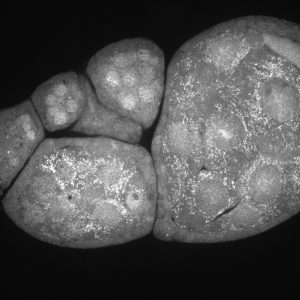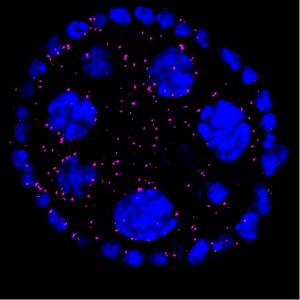What are the mechanisms that drive rejuvenation of meiotic cohesion? 
The dogma in the field has been that under normal conditions, cohesion can only be established during S phase. However, we have recently published evidence that, at least in Drosophila oocytes, this is not the case. We have uncovered a cohesion rejuvenation pathway that keeps cohesion intact during the lengthy period of meiotic prophase (Weng et al. 2014). Current experiments are aimed at defining the mechanisms that operate to rejuvenate cohesion during meiosis, and determining whether aging causes defects in this process that ultimately lead to weakening of cohesion.
How does oxidative damage contribute to meiotic segregation errors?
Oxidative damage accumulates with age and has been proposed to lead to segregation errors in human oocytes. Given the difficulty of demonstrating a causative effect of reactive oxygen species (ROS) on meiotic segregation defects in human oocytes, our ability to mimic age-dependent nondisjunction (NDJ) in flies and to genetically manipulate Drosophila oocytes provides a powerful approach to address this question. Our work has provided the first demonstration that induction of oxidative stress during meiotic prophase causes loss of cohesion and chromosome segregation errors (Perkins et al., 2016). We are currently pursuing both a candidate approach as well as an unbiased mass-spec proteomics approach to identify oocyte proteins that incur oxidative damage under conditions of induced oxidative stress or aging.
Do Sirtuins promote accurate segregation during female meiosis?
Sirtuins are a highlyconserved family of NAD+-dependent deacetylases that have been shown to extend lifespan in yeast, worms and flies and to regulate several aspects of mammalian metabolism and cellular homeostasis. Significantly, small molecule activators of Sirtuins delay aging in worms and flies and have been demonstrated to elicit broad health benefits in mammals. Links between Sirtuin activity and oxidative stress and a documented role of Sirtuins in mammalian oocytes align with the possibility that a decline of Sirtuin activity in older oocytes may contribute to the maternal age effect. We are in a unique position to test this hypothesis using fruit flies. A major advantage of our proposed genetic strategy is that we can directly measure segregation errors and determine whether chiasmata are destablized (because cohesion is lost) when Sirtuin levels are reduced in oocytes during meiotic prophase.
 Can dietary supplementation suppress age-dependent segregation errors?
Can dietary supplementation suppress age-dependent segregation errors?
The ability to slow down the loss of cohesion in aging human oocytes would represent a major step forward in preventing miscarriages and birth defects. Dietary supplementation studies in Drosophila have made important contributions in our understanding of aging and/or metabolic regulation in humans. We have developed a standardized protocol that allows us to mimic (at least in part) the normal aging process that human oocytes undergo within the ovary during a female’s lifespan (Jeffreys et al., 2003). When we subject adult Drosophila females to this aging regimen, their oocytes spend ~20 times longer than usual in a diplotene-like state (the stage at which human oocytes remain arrested for decades (Subramanian and Bickel, 2008). Using this approach, we demonstrated that loss of cohesion occurs when Drosophila diplotene oocytes undergo aging, resulting in chiasma destabilization and missegregation of recombinant chromosomes during meiosis I. We are starting to explore strategies to ask whether feeding adult females specific dietary supplements (such as antioxidants) can suppress the age dependent segregation errors we observe in Drosophila oocytes.
Save
Save
Save

